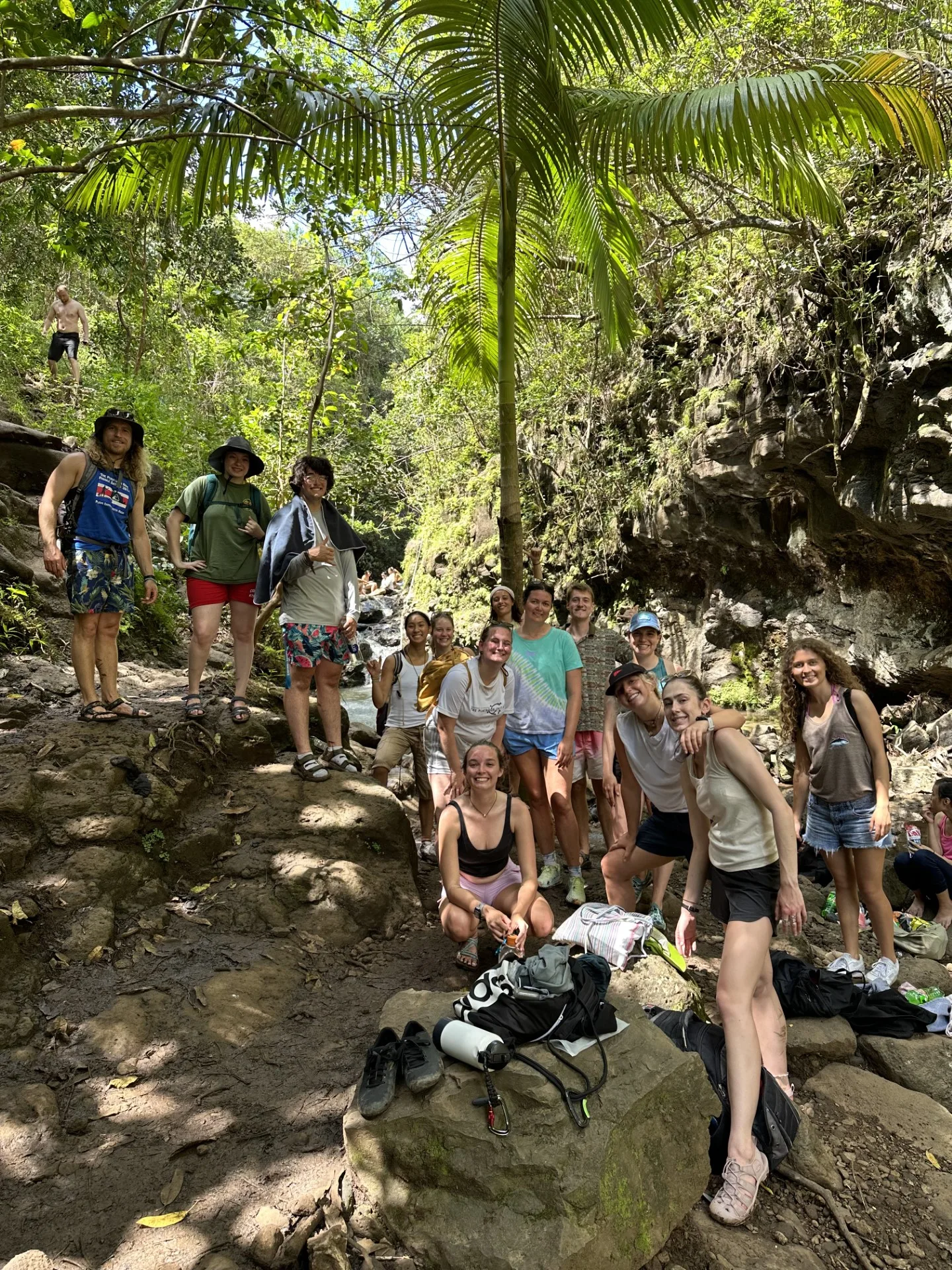Programs Blog
Environmental Conservation and Lobster Suit Trendsetters

May 30, 2023
Maya Hart, Wellesley College
Ship’s Log
Location
Oahu, Hawaii
Weather
Hot and partly cloudy, some showers
The first thing in our action packed day was Nautical Science class! We learned how and when to execute emergency protocols while on the ship. Abandoning ship is an order that can only be given by the captain and occurs when the ship becomes more unsafe than being in the small boats. If this were to occur, it is important that you have some kind of personal floatation device (PFD) before going overboard. Captain Rebecca brought some PFD’s and survival suits from Seaman’s for us to practice. The survival suits provide warmth to prohibit hypothermia and floatation. It was fun trying to put on the suits properly, first the feet, then the non-dominant arm, the hood, the dominant and try to zip with the oven glove hands. We definitely had to help each other out with the zippers and the velcro going over the chin. The suits were clearly doing their job because just after being in it for a couple minutes we were all profusely sweating. It was definitely a site to see, some might even say the start of a new fashion trend and the cat walk really helped show it off.
 Survival suits or lobsters at prom… hard to tell
Survival suits or lobsters at prom… hard to tell
After class we were lucky to welcome guest speaker, Matt Ramsey, from Conservation International Hawaii to speak about their mission which aims to protect nature for the sake of the well being of people. It was interesting to learn about the diversity of the organizations they partner with to encourage sustainable practices. They purposefully work with well known, popular companies like Starbucks and Walmart that have some of the greatest environmental impacts, to enforce sustainable practices. Through their partnerships, they find ways to benefit the company while instilling sustainable practices. Many of these sustainable practices are rooted in traditional Hawaiian practices which are not recognized by the government. For example, he spoke about a method in which the Hawaiian people would feed fish pumpkin and taro. This deterred predators, and fattened them up. After the fish spawn, they would put some of this food in the water and then use a net to catch a large amount.
The link below has more detailed information about the mission of Conservation International Hawaii and the video succinctly summarizes their mission in Hawaii which is the only office in the United States.
https://www.conservation.org/places/hawaii
After stopping for lunch, we drove to Waimano Falls. It was about a mile and half hike to the falls. It was muddy terrain, covered in roots and at some points there were ropes to help you safely get down. But the hike was so worth it! The waterfall was beautiful and there were two smaller pools below the main waterfall. In the bottom pool, there was an awesome rope swing that a lot of people swung off of. Oh and we spotted a little mongoose taking a sip of water in the little creek running off of the last pond. That little guy blended right in!
On the way back we stopped for shave ice and some of the famous malasadas at Leonard’s Bakery. Both were very tasty. We ended the day with Little Caesars pizza thanks to Jeff, and are going to bed excited for our reef surveys tomorrow.
I have really enjoyed getting to know my fellow SEA 309 classmates so far and feel like we’re growing closer everyday. I’m looking forward to our last few days in Oahu and can’t wait to begin our adventures at sea!
Sending love to Mama, Papa, Zoe and Samwise back in the Bay Area. Miss you and looking forward to telling you more about my adventures in person. 🙂
Maya Hart, Wellesley College
Recent Posts from the Ships
- Ocean Classroom 2024-A collaborative high school program with Proctor Academy
- Collaborations and Long-term Commitments: SEA’s Caribbean Reef Program Sets a Course for Coastal Programs that Compliment Shipboard Experiences.
- Sea Education Association students prepare for life underway using state of the art nautical simulation from Wartsila Corporation.
- SEA Writer 2022, Magazines From the Summer SEA Quest Students
- Technology@SEA: Upgrades Allow Insight into Ocean Depths
Programs
- Gap Year
- Ocean Exploration
- High School
- Science at SEA
- SEA Expedition
- SEAScape
- Pre-College
- Proctor Ocean Classroom
- Protecting the Phoenix Islands
- SPICE
- Stanford@SEA
- Undergraduate
- Climate and Society
- Climate Change and Coastal Resilience
- Coral Reef Conservation
- Marine Biodiversity and Conservation
- MBL
- Ocean Exploration: Plastics
- Ocean Policy: Marine Protected Areas
- Oceans and Climate
- Pacific Reef Expedition
- The Global Ocean: Hawai'i
- The Global Ocean: New Zealand